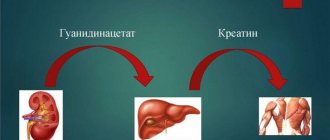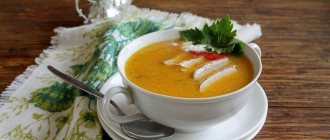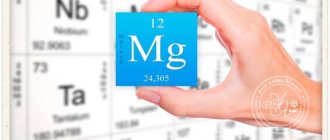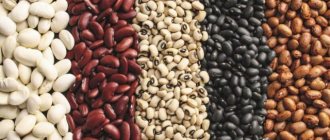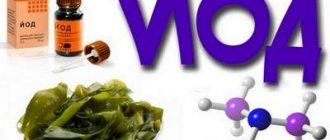Dietary properties of soy:
How many calories are in soybeans, what beneficial properties this plant has, all this is of great interest to those who lead a healthy lifestyle and monitor their health. So we will try to answer these questions in the following article.
So:
In terms of nutritional properties, soybeans are not inferior to ordinary peas, and even surpass them. Its proven properties:
- it reduces the level of “bad” cholesterol (contains vitamins B3 and B12);
- prevents osteoporosis (it contains a lot of calcium and vitamin A);
- allows you to lose weight (it contains very few carbohydrates, which are also well absorbed);
- improves a woman’s condition during menopause (regulates hormonal levels).
Vitamin content
Table 1
| Vitamins | Content | Daily norm |
| A (retinol) | 12 mcg | 1.2 % |
| E (α-, β-, γ-tocopherols) | 1.9 mg | 19 % |
| B1 (thiamine) | 0.94 mg | 62.67 % |
| B2 (riboflavin) | 0.22 mg | 12.22 % |
| B3 (PP) (nicotinamide) | 9.7 mg | 51.05 % |
| B4 (choline) | 270 mg | 54 % |
| B6 (pyridoxine) | 0.85 mcg | 42.5 % |
| B9 (folacin) | 200 mcg | 100 % |
Soy contains both high and low levels of vitamins when considered according to approved nutritional significance standards.
At the highest level of importance in the food value chain are:
- E, keeps the muscular system in good shape.
- B1, required to normalize the nervous and muscular systems.
- B2, maintains body tone.
- PP, participates in the formation of hemoglobin.
- B4, is involved in the biosynthesis of heme and proteins, cell proliferation, and tissue respiration.
- B6, participates in the metabolism of lipids and amino acids.
- B9, supports the hematopoietic and digestive system.
Vitamins of low content include vitamin A, which takes part in all functions of the body related to its growth and proper metabolism, and preserves the structure of the cornea of the eye.
Soybean composition:
Vitamins:
| Vitamin: | N | IN 1 | AT 2 | AT 4 | AT 5 | AT 6 | RR | E |
| in mg. per 100 grams | 0.06 | 0.94 | 0.22 | 270.0 | 1.75 | 0.85 | 9.7 | 1.9 |
Minerals:
| Mineral: | Calcium | Phosphorus | Magnesium | Potassium |
| in mg. per 100 grams | 348 | 603 | 226 | 1607 |
Its proteins, which are well digestible and are close in amino acid composition to the proteins of milk and meat, are sometimes called vegetable “meat”. On the market they are represented by soy isolate (90% protein), concentrate (70%), soy flour (50%), which are added to various products instead of meat. In Moscow, for example, there are even stores selling products made from these beans.
Plant proteins are absorbed in the intestines by only 60–80% (faster are the proteins of wheat bread made from premium flour and semolina). Their digestion is disrupted by certain substances contained in peas, beans, and soybeans that reduce the digestive activity of digestive enzymes.
Heat and culinary processing (long-term boiling, chopping, rubbing) improve the digestion of vegetable proteins of this plant.
Soy recipes

If their surface is covered with plaque or small specks, the shape of the seeds is uneven - the top layer is chipped, there is a smell of dampness, then the purchase should be discarded. You should only buy beans with a smooth, uniform-colored surface that, when pressed with a fingernail, leaves a dent. It is not recommended to purchase soybeans in pods. Properly selected soybean soaked in water - okara - has a consistency similar to soft cottage cheese, is tasteless and does not smell of anything. Soy Recipes:
- Soy milk
. Approximately 150 g of dry soybeans are soaked overnight in 3.5 cups of cool boiled water. Then this water is decanted, the mass is transferred to a blender, 1.5 cups of clean boiled water are added and brought to complete homogeneity. The procedure is repeated several times, constantly changing the water. To avoid “losing” the okara, use a fine sieve or gauze when decanting the water. After 2-3 decantations, the okara is put in the refrigerator - this is an excellent raw material for cookies or dumplings, and the liquid is set to boil for 2-3 minutes, stirring constantly, otherwise it will run away or burn. You can improve the taste with sugar. Dough is kneaded with milk or cereal porridge is cooked. - Syrniki
. The okara left over from making milk is mixed half and half with cottage cheese, salted, sugar, egg and a little flour are added to give the dough the desired consistency. The cheesecakes are formed and fried on both sides in sunflower oil. - Sweet soy sauce
. Soy sauce for dressing vegetable salads, sushi and rolls can be prepared at home. Ginger root is grated on a fine grater (100 g), mixed with the same amount of fresh orange zest, and placed in a thick-walled frying pan with high sides. They also add soybeans (200 g), which were soaked for 8 hours to start cooking, a tablespoon of spices - cinnamon, ground ginger, anise, finely chopped leeks, 1-1.5 tablespoons of sugar. You can then adjust the seasonings to your liking. Place the frying pan on the stove, add 1.5-2 cups of sherry and cook over very low heat until the volume of liquid is reduced by three. Then the sauce is filtered through a sieve and ground. Should be stored in the refrigerator for no longer than 3 weeks. - Cutlets
. 400 g of soybeans are soaked for 13-16 hours, the water is drained and everything is ground in a blender until smooth. Add 2 tablespoons semolina, finely chopped onion and sautéed in vegetable oil, salt, 1 egg. The cutlets are formed, rolled in formed breadcrumbs and fried in sunflower oil. Pairs with any side dish. - Soy soup
. Soybeans (200 g) are soaked for 12 hours. Beets, onions and carrots - one piece at a time - are chopped and fried in oil. The water is drained from the beans and crushed. Let them cook for 20-30 minutes. At the end of cooking, add vegetables, spices - salt, pepper, bay leaf, garlic and bring to readiness. When serving, add herbs to each plate - dill, garlic or basil. - Cakes
. Soybeans are ground into flour. The recipe is for 3 cups of soy flour. Using a blender, beat the butter and sugar in the proportions of half a glass/glass. Beat 4 eggs with another glass of sugar. The mixtures are combined, brought to complete homogeneity, pour into the dough 1.5 cups of seedless raisins, half a teaspoon of soda and 2 teaspoons of spices - cinnamon, sweet paprika, cloves. Knead the dough, gradually adding soy flour. Bring to a thick puree-like consistency by adding red wine. The cakes are formed, placed on oiled parchment, and baked in an oven preheated to 200 degrees.
Dishes made from sprouted soybean sprouts are extremely popular in cooking. Dry beans are poured with water at a temperature of 22 degrees - its volume should be 4 times more than soybeans, and placed in a dark room for 10 hours. Then the water is decanted, the seeds are laid out on a damp cloth, covered with gauze on top and put in a fairly warm, dark place. Subsequently, they are washed daily and the bedding is changed. As soon as the sprouts reach 5 cm, they can already be cooked. Before heat treatment, sprouted soybeans are washed. Soy sprouts go well with onions, sweet bell peppers, garlic, zucchini, and herbs. Before preparing the salad, the sprouts must be boiled for 15-30 seconds.
Harm to the body
Soybeans have a depressant effect on the endocrine system. With their frequent use, especially in children, problems with the thyroid gland develop. In children under 3 years old, beans can cause allergies. Among other harmful properties of this plant are:
- acceleration of the aging process;
- cerebrovascular accident;
- increased likelihood of Alzheimer's disease;
- increased risk of miscarriage;
- negative impact on the development of the child’s brain in the womb.
Use of the ingredient in cooking

Cooking soybeans is a very lengthy process. The beans are soaked for at least 15 hours, washed in cool water and boiled for about 3-4 hours until tender. Only fruits that have undergone many hours of preparation become edible (raw beans are difficult to even bite through).
Among the products containing soy are:
- tofu cheese;
- yogurt (yofu);
- chocolate;
- cereal protein bars;
- ice cream;
- milk.
All these products are low in calories and can be included in the diet.
After heat treatment, soybeans become soft, slightly crumble and filled with a sweetish, nutty flavor. Boiled beans can be eaten as a side dish, added to salads, served with meat and fish dishes, and even used as a dessert.
In cooking, soybean acts as a vegetable substitute for meat. The ingredient is used to create sauces, oils and drinks. The special extract secreted by soybeans makes the dish incredibly tasty. The combination of tart and sweet nutty notes adds a certain sophistication to the food.
You can also cook from soy:
- pate;
- homemade sausage;
- vegetable stew;
- appetizer with the addition of meat or fish ingredients.
Smooth Pho Soup Recipe Using Soy Sprouts
We will need the following ingredients:
- boiled beef – 250 g (can be replaced with chicken);
- ginger – 50 g;
- onions – 2 pcs.;
- sauce for fish dishes - to taste;
- cinnamon – 2 pcs.;
- star anise – 5 pcs.;
- black peppercorns - to taste;
- rice noodles – 150 g;
- soybean sprouts – 150 g;
- beef broth – 1 l;
- green onions – 4 stalks;
- herbs and spices - to taste.
Preparation
Cut the vegetables into small cubes and chop the selected greens. Pour fish sauce into the meat broth, add onion, ginger, cinnamon, star anise and your favorite spices. Constantly taste the dish to understand the specific taste. As soon as you find the ideal dosage, stop and move on to the next stage of cooking. Bring the spicy broth to a boil and leave to simmer for about 20-30 minutes - this will allow the broth to absorb the flavor of each spice.
Strain the finished broth, add rice noodles and return to medium heat for 5-7 minutes. Remove the finished noodles with a slotted spoon and place on a plate, adding soy sprouts and boiled beef. Pour the dish with meat broth, add a drop of lime or lemon and serve.
Indications and contraindications for use
Soybean dishes are consumed not only to diversify the diet, but also for certain indications. The beneficial effect of this product on the body helps improve the condition of certain diseases. Their list includes:
- arthrosis and arthritis;
- myocardial infarction;
- cholecystitis;
- chronic constipation;
- hypertension;
- ischemia;
- allergy to animal protein;
- atherosclerosis;
- gout

IS SOYA HARMFUL FOR HEALTH: CONTRAINDICATIONS
Today there is widespread information that eating soy negatively affects the functioning of the thyroid gland. This is true, but applies to those who eat it regularly and in large quantities. This effect is associated with goitrogenic substances (which, by the way, are also present in large quantities in millet, cabbage, asparagus, radishes, horseradish, and turnips). They disrupt the functions of the thyroid gland and lead to the appearance of goiter if the diet contains few iodine-containing foods. If goitrogenic substances are balanced due to the presence of iodine, the risk is significantly reduced.
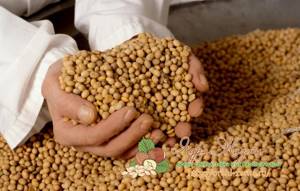
It should be remembered that soy products are strong allergens. For this reason, they are not recommended to be included in the diet of young children whose bodies are not yet strong enough. By having a strong effect on the functioning of the thyroid gland, soybeans can lay the foundation for the occurrence of various diseases in the future.
WHAT IS SOYA DANGEROUS FOR HUMANS?
Modern medicine recommends avoiding soy products for people who have dysfunction of the thyroid gland and the entire endocrine system. Moreover, you should be examined by a doctor if problems begin after including soy in your diet. Ignoring it is fraught with weakness, the development of pathologies of other organs and systems, and serious disorders of the immune system and metabolism. Consumption should also be limited if you have urolithiasis, since in some cases soybeans provoke the formation of deposits.
For the reasons described above, soy foods may have a negative impact on brain function, especially if you are at risk of developing Parkinson's disease, Alzheimer's disease, or senile sclerosis.
Modern researchers claim that frequent consumption of soy is harmful to the male body, suppressing “male power.” The reason for this again lies in hormones - endocrine functions are disrupted, as a result of which sperm activity and testosterone production decrease.
HOW IS SOY CONSUMPTION JUSTIFIED DURING PREGNANCY AND LACTATION?
Soy for women nursing or bearing babies cannot be a strictly prohibited product, but its use should be treated with rational caution. Overall, it is good for the body as it provides a lot of protein, fatty acids, folic acid and antioxidants.
However, during lactation and pregnancy, harm from soy is also possible:
- The presence of estrogen-mimicking substances can adversely affect the functioning of the thyroid gland.
- Excessive fiber disrupts the healthy functioning of the gastrointestinal tract, leading to bloating, flatulence, and colic.
- It is one of the strongest allergens to which babies are very vulnerable.
Soybeans and their derivatives should not be included in a child's diet until basic development of the body is completed, so they should be abstained from before reaching six months of age.
SOYBEAN IN CHILDREN'S DIET - OPINIONS OF SCIENTISTS
Conversations about whether soy will be beneficial for children and whether it will lead to developmental complications are still relevant. Supporters of the product point to the centuries-old practice of consuming soy in Japan and China. Opponents refer to modern studies that indicate a negative effect on the functioning of the thyroid gland. The level of individual hormones in a child’s body is very sensitive to diet.
The consequence of this is not always the development of diseases - problems can be expressed in early puberty or increased levels of certain hormones (for example, estrogen in boys). It is best to eliminate the possibility of complications by giving such food to your child with great caution until he reaches one year of age.
IS SOY BEAN HEALTHY OR HARMFUL - WHAT IS MORE?
We can say that for a person who does not limit himself in any way in consuming certain products, soy is not a very healthy product, but not a harmful product either. For the sake of taste and a new culinary experience, it can be used.
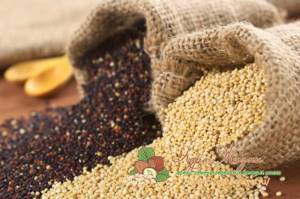
And for the body, which, due to the refusal of meat, receives little protein, the inclusion of soy products in the diet is more beneficial than not. The main thing is to maintain a balance between abundance and abuse. Once you are sure that it does not provoke diseases and does not impair the functioning of internal organs, you can use this useful and affordable product with peace of mind. In short, knowing in which cases soy is harmful and in which it can be good for the body, you can quite confidently include it in your diet without fear of serious consequences.
Soy formula for children with allergies to cow's milk protein

Soy formula for newborns is an alternative to cow's milk-based milk nutrition for children who cannot consume it due to allergies to lactose and milk protein. They contain vegetable soy protein, vitamin supplements, micro- and macroelements. The opinion that these products are hypoallergenic is erroneous - children may be intolerant to soy vegetable protein, so inclusion in the diet requires a doctor’s recommendation.
Pediatricians strongly do not recommend using soy formula for feeding “healthy” newborns (without allergies), because this leads to lack of nutrition and low body weight. Indications for the use of soy mixtures are:
- acquired, temporary or congenital lactose deficiency;
- allergy to cow, goat or breast milk;
- viral diarrhea;
- galactosemia (disorder of galactose metabolism).
Soy in sports nutrition
Despite the debate about the benefits and harms of soy products, the protein obtained from the plant's beans is the basis of sports nutrition. It is important for those involved in bodybuilding and fitness. Soybean isolate is used as a source of protein, supplying the cells with amino acids and giving them energy. The protein-rich nutritional supplement can be taken diluted with water or juice.
Protein is consumed an hour before or after training. This is necessary to nourish the muscles of an athlete experiencing heavy loads. Consultation with a doctor is required.
Useful properties of the product
Soybeans and products made from it have many beneficial properties. Soy products prevent allergies, osteoporosis, and prevent the development of diseases of the cardiovascular system, including hypertension and coronary heart disease. The indication for their use is the presence of excess weight. Thanks to lecithin, which is part of soy, fat metabolism in the body is accelerated, resulting in a decrease in the amount of fat deposits.
The product can be eaten both in pure form and in various products. For example, soy goulash is popular as a first course.
Soy contains stachinoses and raffinoses - substances necessary for the nutrition of intestinal bifidobacteria, which contribute to an increase in their number. They reduce the risk of dysbacteriosis, which significantly slows down the aging process of the body, increases life expectancy and has the most favorable effect on human health.
Soy helps get rid of osteoporosis. It contains isoflavones that compensate for the lack of female sex hormones - estrogens. Their deficiency is the main cause of the development of this disease in women during menopause. Soy contains a sufficient amount of calcium, the main component of bone tissue.
Soy milk helps relieve ulcers and gastritis. In appearance, the drink resembles cream or regular milk. The product has a sweetish taste and contains many protein compounds, minerals and B vitamins. It is quickly absorbed by the body and reduces the secretion of gastric juice.
Important components contained in soy are choline and lecithin. Their usefulness is due to their ability to restore nerve tissue and brain cells. They are responsible for erectile and motor functions, the thinking process, attentiveness, and the ability to remember and assimilate new information. These components are involved in the metabolism of fats and help reduce cholesterol levels in the blood.
The list of diseases for the treatment of which it is advisable to include soy products in the regimen includes:
- Parkinson's disease;
- diabetes;
- inflammation of the gallbladder;
- liver diseases;
- dystrophic changes in muscle tissue;
- glaucoma;
- cholecystitis;
- exhaustion of the body;
- weakening of memory.
Soy products are used to prevent cancer. Isoflavonoids similar to estrogens prevent the development of hormone-dependent cancer. The growth of tumor tumors is suppressed by phytic acids. Soy products also contain a component called genestein. It is able to stop metastasis and prevent the progression of some forms of cancer in the initial stages of their development.
SOY BENEFITS AND HARM
Soybean is a herbaceous plant that actively grows on all continents of the Earth. Soybeans are not technically beans, but are called so due to their similar appearance and being a member of the legume family. Research by scientists says that they have been used as food for more than 3 thousand years.

Due to the high content of protein, vitamins and minerals in the composition, today soy products are used as an effective alternative to dairy and meat foods.
Origin
The plant's supposed homeland is China; mention of its cultivation was found in ancient Chinese writings dating back to the 4th-3rd century BC. Subsequently, soybeans migrated to Korea, and from there to Japan.

The plant first came to Europe in the 18th century. The Americans became interested in the properties of beans and conducted their research in 1804. Since 1898, samples of varieties were brought to the USA, after which its cultivation began on an industrial scale. In Russia, they were engaged in soybean breeding at the beginning of the 20th century, then the plant was forgotten due to the widespread cultivation of corn.
